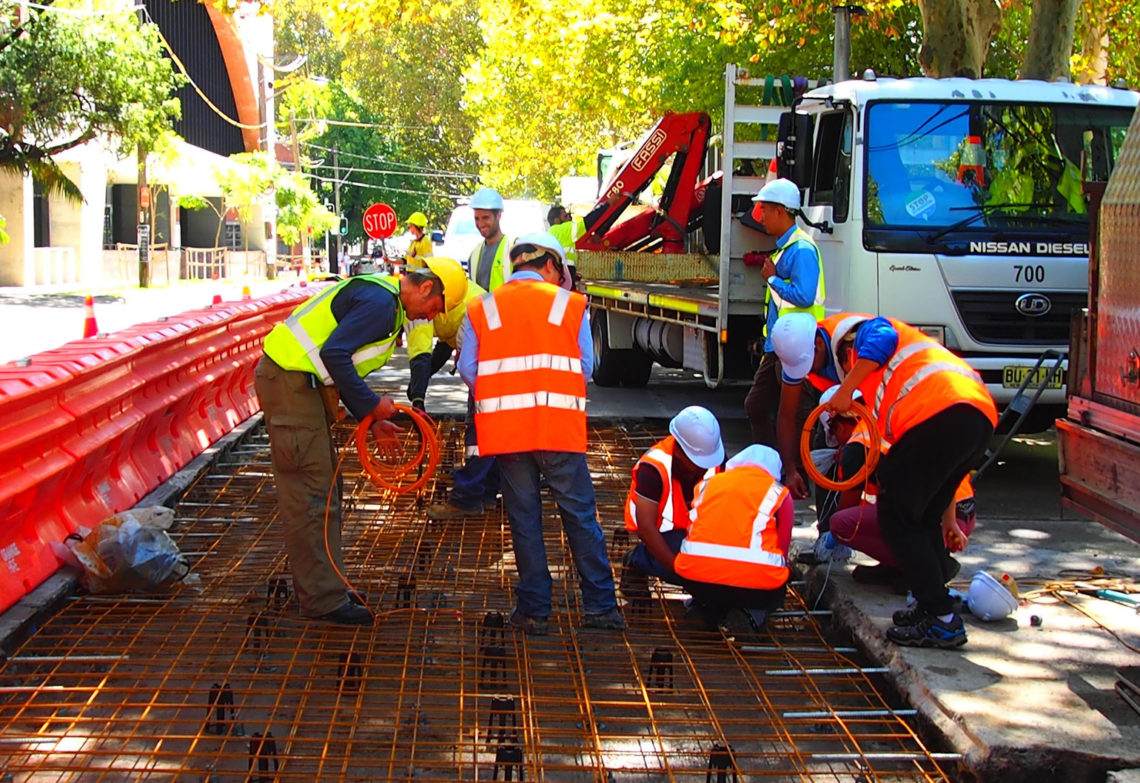The streets of a Sydney suburb will serve as a testing ground for a new geopolymer concrete made from recycled industrial waste.
Fly ash and blast furnace slag from coal-fired power stations and steel manufacturing have been repurposed into concrete to replace a 30-metre section of Wyndham Street in the busy suburb of Alexandria.
Nine sensors positioned under the road will monitor the new material’s performance for up to five years to see how it holds up to the wear and tear of inner-city traffic.
“This trial will help drive step change in the industry. Many concrete companies are already doing a lot to change, but this trial really gives it another push,” said Professor Stephen Foster, head of the School of Engineering at the University of NSW (UNSW).
Geopolymer has been a material of interest for a couple of decades, but it’s only now starting to be commercialised as a more sustainable alternative to virgin materials.
Foster said trials like this are important to test the viability of geopolymers as an alternative material.
“We need demonstration projects to accurately assess the performance of geopolymer over time so that there can be broader uptake,” he said.
Craig Heidrich, executive director of the Australian Iron and Steel Association and the Ash Development Association (who partnered on the project), said the outcomes of this trial will help “demystify and promote” the use of geopolymer concrete in construction.
“Geopolymer concrete has great engineering properties. It is a durable, high-performance product that has a low-carbon footprint when used in construction,” he said.
“It’s a fundamental tenet in business that you need to be constantly innovating and investing into new technologies. This trial will provide real examples of geopolymer concrete use that we can all use.”
Paved with green
Concrete is literally the foundation of our built environment – it’s one of the most widely used substances on the planet, right up there with water. But the concrete industry is also a major contributor to carbon emissions.
Cement, one of the main ingredients in concrete, is responsible for almost 7 per cent of CO2 emissions.
“In 2018, the world produced about 4.1 billion tonnes of cement, which contributed about 3.5 billion tonnes of CO2,” Foster said.
“Alternative, low-CO2 concrete materials offer potential benefits in reducing greenhouse gas emissions associated with conventional concrete.”
Foster has high hopes for this geopolymer trial. If successfully commercialised, the material could help reduce the emissions generated during cement production by two-thirds. What’s more, it could also put the 400 million cubic tonnes of waste generated by the coal and steel industries to good use.
UNSW researchers and the CRC for Low Carbon Living (CRCLCL) will also use results from this trial to create the industry’s first set of guidelines for geopolymer concrete.
“While we’ll monitor the road performance for up to five years, a lot of the data collected in the first three to 12 months of this world-first trial will be used to confirm our models and strengthen our predictions,” Foster said.
Trial by trial
With construction a constant occurrence in Sydney, Lord Mayor Clover Moore said she was interested to see how new products can help slash the city’s carbon emissions.
“Local governments are responsible for maintaining local roads, so if we can purchase more environmentally friendly materials, we can fight climate change and provide quality infrastructure for our community,” she said.
She added that the city already uses sustainably sourced concrete for footway renewal projects, but that “we’re continually working with concrete suppliers to reduce the amount of pollution and greenhouse gases emitted during the production of concrete for our local roads”.
Other trials have looked at innovative ways to incorporate recycled materials into roads. One project from last year used recycled asphalt with an additive made from recycled bags, printer cartridges and glass bottles to resurface a road in Melbourne.
And Australian company Flexiroc is putting old tyres to use as a free-draining concrete solution beneath thoroughbred race tracks and sports fields.




I remember, when I was with BMI Ltd in the early 70s, Mick Ryan amongst others, using fly ash in concrete. I also heard of trials of slag aggregate in concrete, at that time.
It shows there is nothing new under the sun!